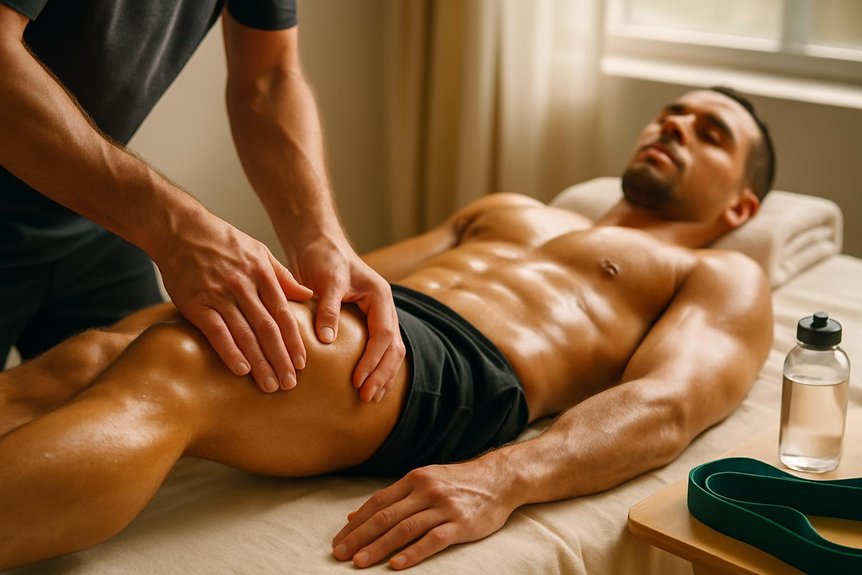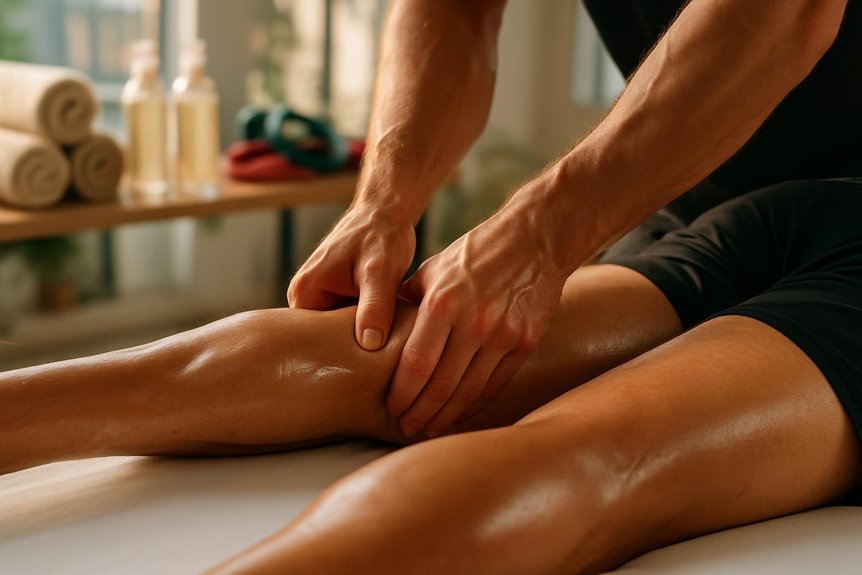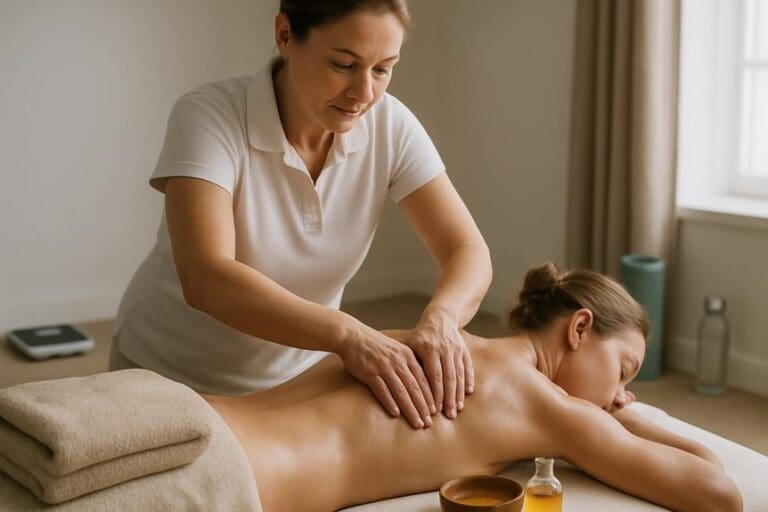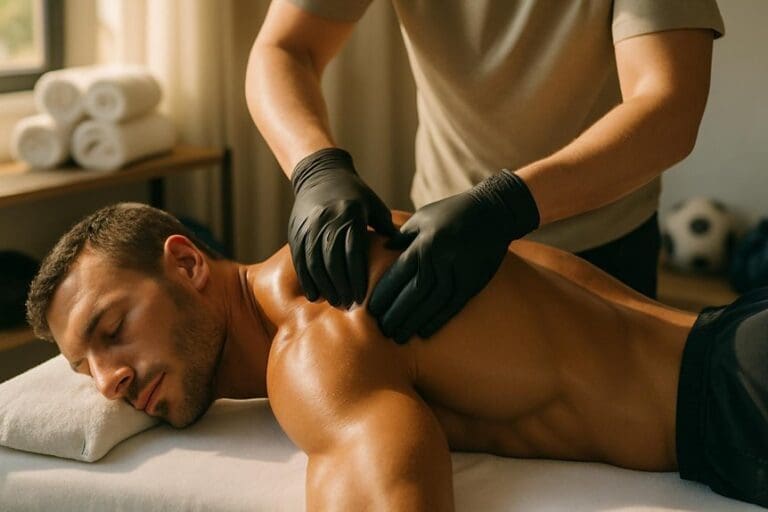This is a clinical intervention that uses targeted manual techniques to address biomechanical and physiological demands on soft tissues during physical activity. It employs evidence-based methods such as effleurage, petrissage, and myofascial release to enhance circulation, remove metabolic waste, and promote tissue elasticity. This modality is integral for injury prevention, recovery, and maximal neuromuscular function in athletes and active individuals. Further exploration provides insight into its protocols, benefits, and structured approach to musculoskeletal care.
The Principles and Purpose

How does this massage function within the domain of musculoskeletal health? Sports massage is designed to address the biomechanical and physiological demands placed on muscle tissue, tendons, ligaments, and fascia during physical activity. By targeting soft tissue structures, it aims to reduce delayed onset muscle soreness, enhance local circulation, and facilitate the removal of metabolic waste. The intervention further seeks to promote tissue elasticity and *maximize* neuromuscular function, supporting injury prevention and recovery. At Spa & Massage, therapists implement evidence-based protocols to identify tissue dysfunctions and support active or sedentary clients alike. The purpose extends beyond post-exercise relief; it encompasses pre-event preparation, maintenance of *prime* tissue tone, and targeted support of anatomical structures under strain. This approach embraces holistic, individualised musculoskeletal health for all activity levels. Unlike this massage, practices such as reflexology use specific pressure techniques on the feet and hands to help promote overall balance and healing within the body.
Techniques Used in Spa & Massage
Within the scope of this massage at Spa & Massage, therapists employ a systematic repertoire of manual techniques grounded in anatomical and physiological principles. These include effleurage to facilitate superficial venous and lymphatic return, petrissage to mobilise deeper soft tissue structures, and friction techniques targeting adhesions within muscle fibres and connective tissue. Myofascial release is applied to address fascial restrictions, while neuromuscular techniques focus on trigger points to alleviate localised hypertonicity. Therapists integrate stretching modalities—both passive and active—to support ideal muscle length and joint range of motion. Each intervention is adapted to the individual’s musculoskeletal presentation, ensuring targeted engagement of specific muscle groups. Through attentive palpation, therapists maintain continuous feedback, adjusting pressure and technique in response to tissue response and client comfort.
Key Benefits for Athletes and Active Individuals
It confers measurable benefits for athletes and active individuals, including facilitation of muscle recovery through increased local circulation and metabolic waste removal. Evidence-based protocols support its role in injury prevention by addressing soft tissue dysfunction and promoting ideal musculoskeletal alignment. These interventions collectively contribute to improved athletic performance by enhancing range of motion, neuromuscular coordination, and tissue resilience.
Enhanced Muscle Recovery
Enhanced muscle recovery represents a primary advantage of targeted manual therapy for athletes and physically active individuals. This therapy, as practiced at Spa & Massage clinics, employs specific techniques such as effleurage, petrissage, and friction to facilitate venous return, enhance lymphatic drainage, and expedite the removal of metabolic by-products like lactic acid from muscle tissue. These interventions support a reduction in delayed onset muscle soreness (DOMS) and decrease localised inflammation, fostering ideal cellular repair. By stimulating proprioceptive sensors and increasing local blood flow, therapists encourage more efficient oxygen and nutrient delivery to myofibrils, accelerating tissue regeneration. This evidence-based approach enables clients to resume training with improved muscle function and diminished fatigue, reflecting Spa & Massage’s commitment to anatomically precise, client-centred therapeutic care.
Injury Prevention Strategies
Alongside accelerated muscle recovery, structured manual therapy serves a proactive role in injury prevention for athletes and active individuals. This specialized therapy, as practiced by Spa & Massage clinics, targets myofascial adhesions, enhances soft tissue pliability, and facilitates ideal joint range of motion. By systematically addressing muscular imbalances—particularly in high-load regions such as the hamstrings, quadriceps, and rotator cuff—therapists reduce microtrauma accumulation and the risk of overuse syndromes. The application of evidence-based techniques, including deep tissue manipulation and neuromuscular trigger point therapy, stimulates proprioceptive feedback and modulates local inflammation. This anatomical focus allows for early detection of dysfunctional tissue patterns. In our clinical experience, regular intervention preserves connective tissue integrity, fosters resilience, and supports the unique biomechanics of each client, providing an intimate safeguard against preventable injuries.
Improved Athletic Performance
By facilitating ideal neuromuscular coordination and circulatory efficiency, manual massage confers measurable gains in athletic performance. Enhanced blood flow promotes optimal oxygenation and nutrient delivery to muscle fibres, accelerating metabolic waste removal and reducing fatigue. Precise manipulation of myofascial tissue at Spa & Massage clinics targets adhesions and trigger points, restoring muscle pliability and full range of motion. Neurological stimulation through skilled manual techniques optimises proprioceptive feedback, supporting improved reaction time and movement precision. Regular massage sessions also modulate sympathetic activity, minimising stress-induced muscle tension and enabling athletes to maintain biomechanical efficiency. For clients pursuing personal bests or preparing for competition, it offers a direct, evidence-based approach to maximising strength, endurance, and flexibility, all within a supportive and expertly guided therapeutic environment.
How it Supports Injury Prevention and Recovery
It is clinically shown to enhance muscle flexibility by promoting myofascial release and improving soft tissue elasticity. Targeted manual techniques assist in reducing localized inflammation and nociceptive pain, supporting ideal tissue recovery. At Spa & Massage, therapists utilize evidence-based protocols to address musculoskeletal imbalances and facilitate injury prevention.
Enhancing Muscle Flexibility
How does targeted manual therapy influence muscle compliance and functional range of motion? Clinical evidence demonstrates that this massage techniques—such as myofascial release, passive stretching, and deep tissue manipulation—directly affect the viscoelastic properties of skeletal muscle. By applying precise pressure along muscle fibers and fascia, therapists at Spa & Massage facilitate enhanced extensibility of muscle tissues and reduce neuromuscular tension. This process disrupts adhesions, increases circulation, and promotes ideal alignment of muscle fibers, thereby improving functional length and flexibility. Enhanced muscle compliance is essential for both injury prevention and efficient recovery, as it creates an environment where tissues can adapt to mechanical load with reduced risk of strain. At Spa & Massage, therapists tailor interventions to anatomical needs, prioritizing safe, sustained improvements in range of motion.
Reducing Inflammation and Pain
When acute or chronic soft tissue stress initiates an inflammatory cascade, targeted manual interventions can modulate both nociceptive signaling and localized edema. This therapy, as practiced by skilled therapists at Spa & Massage, employs specific techniques such as effleurage and petrissage to facilitate lymphatic drainage and enhance local circulation. This process aids in the removal of metabolic by-products, limiting the persistence of inflammation and reducing interstitial fluid accumulation. Additionally, mechanical stimulation of soft tissues can downregulate pain mediators and interrupt feedback to peripheral nociceptors. The result is a measurable decrease in pain perception and tissue tenderness, supporting a more efficient recovery trajectory. By integrating evidence-based protocols, Spa & Massage maximizes both anti-inflammatory and analgesic benefits, promoting long-term musculoskeletal health and injury resilience for their clients.
What to Expect During Your Appointment
A typical session at Spa & Massage begins with a targeted assessment of the client’s musculoskeletal system, focusing on areas of tension, restricted range of motion, and soft tissue adhesions. Therapists employ palpation techniques and active movement screens to identify muscular imbalances and fascial restrictions. Utilizing evidence-based protocols, the practitioner applies a combination of deep tissue manipulation, myofascial release, and neuromuscular techniques, always adjusting pressure based on tissue response and client feedback. The session prioritizes anatomical precision, addressing specific muscle groups—often including the quadriceps, hamstrings, calves, trapezius, and rotator cuff complex. Throughout, the environment remains tranquil and private, fostering a sense of trust and therapeutic connection. This individualized approach at Spa & Massage allows clients to experience both clinical efficacy and attentive, personal care.
Aftercare and Recommendations for Lasting Results

Optimal therapeutic outcomes following a sessions at Spa & Massage depend not only on the treatment itself but also on adherence to evidence-based aftercare protocols. Immediate hydration is essential to facilitate metabolic waste elimination from soft tissues. Clients are advised to engage in gentle stretching, promoting myofascial lengthening and reducing post-massage muscle stiffness. Application of cold or warm compresses, as individually indicated by the therapist, may assist in modulating localized inflammation or supporting circulation. Restorative rest is encouraged to allow musculoskeletal and connective tissue repair. At Spa & Massage, therapists provide tailored post-session guidance, emphasizing gradual return to intense physical activity and recommending follow-up sessions based on biomechanical assessments. Such practices enhance the longevity of therapeutic benefits and foster a deeper connection with one’s own body.
Conclusion
Much like a finely tuned engine requires regular calibration to sustain peak function, the human musculoskeletal system benefits from targeted interventions. Studies indicate that this massage can reduce delayed onset muscle soreness by up to 30%. At Spa & Massage, this evidence-based approach acts as essential maintenance—optimizing flexibility, circulation, and recovery. Just as precision engineering prolongs machinery life, clinical massage supports anatomical integrity, ensuring individuals remain resilient and high-performing across all physical demands.



